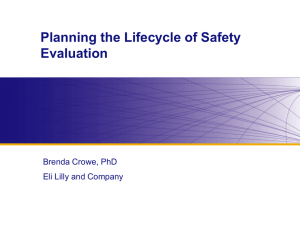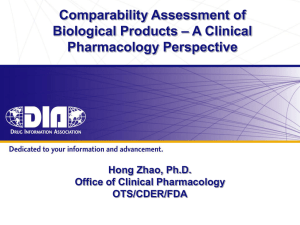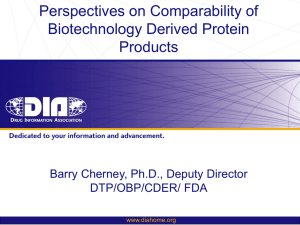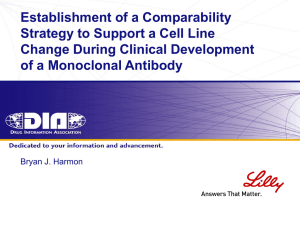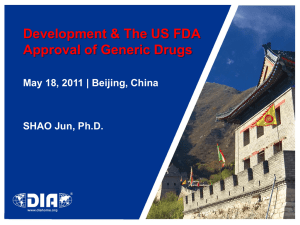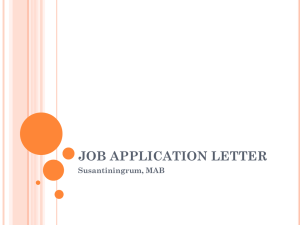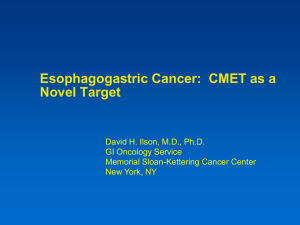Case study - Drug Information Association
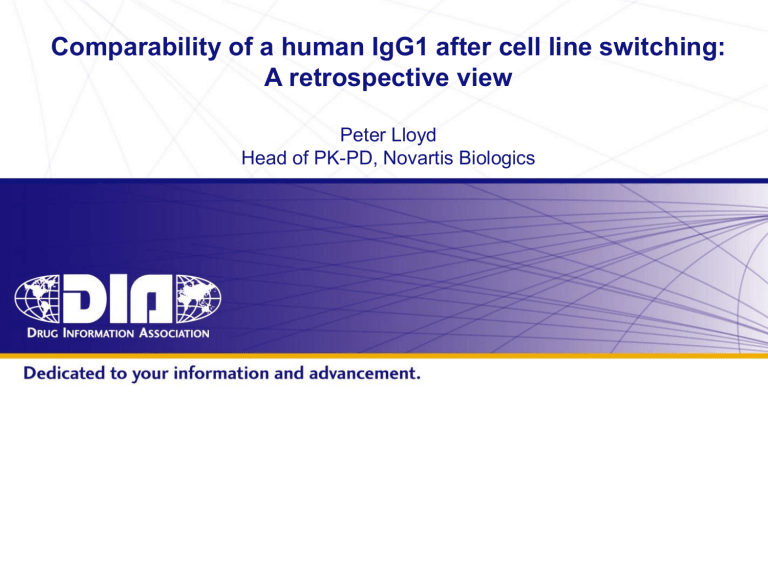
Comparability of a human IgG1 after cell line switching:
A retrospective view
Peter Lloyd
Head of PK-PD, Novartis Biologics www.diahome.org
Disclaimer
The views and opinions expressed in the following PowerPoint slides are those of the individual presenter and should not be attributed to Drug
Information Association, Inc. (“DIA”), its directors, officers, employees, volunteers, members, chapters, councils, Special Interest Area
Communities or affiliates, or any organization with which the presenter is employed or affiliated.
These PowerPoint slides are the intellectual property of the individual presenter and are protected under the copyright laws of the United
States of America and other countries. Used by permission. All rights reserved. Drug Information Association, DIA and DIA logo are registered trademarks or trademarks of Drug Information Association Inc. All other trademarks are the property of their respective owners. www.diahome.org
Outline of the presentation:
Introduction to case study:
IgG PK and mAb-ligand binding models:
- consequences for characterisation of extent and duration of effect
Retrospective analysis:
- can rodent replace NHP in PK studies to explore inherent IgG behaviour?
- can immunogenic potential be detected with appropriate PK and PD analytical strategies?
- can appropriate clinical strategies during clinical development provide more definitive information on comparability?
Summary:
“yes they can” www.diahome.org
Case study:
IgG
1 monoclonal Ab
binds to and neutralises a soluble cytokine target
- target not detected at baseline in systemic circulation
cross-reactivity established with marmoset and human target (similar affinity)
PK assay for total drug in serum (marmoset / human)
PD assay for total ligand in serum (human) www.diahome.org
Case study:
Product A
NS0-derived
≥52 mg/mL
Product B
Sp2/0-derived
≥65 mg/mL
Product C
Sp2/0-derived
≥180 mg/mL
Product D
Sp2/0-derived
≥175 mg/mL
- human and marmoset crossreactivity
Comparability exercise:
- phys - chem
PK (NHP)
-marmoset: 4 and 26 wk iv,
13 wk s.c. toxicology and
EFD
Clinical studies Clinical studies
-
Comparability exercise:
- phys - chem
PK (NHP)
-
Comparability exercise:
- phys - chem
NS0 = expression cell line (mouse myeloma)
Sp2/0 = expression cell line (mouse myeloma) HSA = Human serum albumin www.diahome.org
Case study:
Research Pre-clin Phase I Phase II Phase III Phase IV cell line switch www.diahome.org
Case study: PK comparability non-human primate
100000
10000
– NSO
– SP2/0 single sc dose x-over study n=16 marmosets
PK comparability established:
- AUC
- C max and t max
1000
100
0 10 20 30 40 50 www.diahome.org
Outline of the presentation:
Introduction to case study:
IgG PK and mAb-ligand binding models:
- consequences for characterisation of extent and duration of effect
Retrospective analysis:
- can rodent replace NHP in PK studies to explore inherent IgG behaviour?
- can immunogenic potential be detected with appropriate PK and PD analytical strategies?
- can appropriate clinical strategies during clinical development provide more definitive information on comparability?
Summary: www.diahome.org
A simple mAb PK model:
mAb iv dose elimination mAb slow clearance
V ~ 7L t
½
~ 300 h (human)
FcRn protects IgG from degradation & explains long serum half-life
Roopenian and Akilesh.
Nature Reviews Immunology 2007; 7: 715 www.diahome.org
Mouse, rat and cyno FcRn recognize human IgG
man
IgG kinetics scale reasonably well using an allometric approach
NB only when target mediated disposition is absent rat non-human primate mouse www.diahome.org
A simple mAb PK-PD model:
input ligand mAb + dose elimination mAb slow clearance
V ~ 7L t
½
~ 300 h ligand elimination ligand mAb – ligand complex elimination mAb
– ligand complex www.diahome.org
Components of the PK-PD model:
Inherent pharmacokinetics of the mAb (IgG behaviour):
- species differences often well understood and easily characterised; good prediction to man
Binding affinity to the target ligand:
- species differences understood during characterisation of the mAb
Turnover of the ligand and clearance of the mAb-ligand complex:
- species differences and behaviour of mAb-ligand complex sometimes not well understood
- if cell surface ligand is not saturated with mAb then the mAb-ligand complex may be cleared very quickly (target mediated clearance)
- for a soluble ligand the mAb-ligand complex will tend to follow IgG clearance mechanisms (eg case study) www.diahome.org
Case study: PK-PD model
soluble ligand
0.8
0.6
0.4
0.2
1.2
1.0
Single dose:
0.01 mg/kg
0.1 mg/kg
1.0 mg/kg
10.0 mg/kg
0.0
20 40 60 80 100 120
Time (days)
Assumptions mAb with typical IgG kinetics; Kd = 0.37nM; soluble ligand, turnover (half-life 3h) www.diahome.org
Literature example:
cell surface ligand anti-CD11a mAb – Raptiva (efalizumab)
Joshi et al An overview of the pharmacokinetics and pharmacodynamics of efalizumab: a monoclonal antibody approved for use in psoriasis
J Clin Pharmacol 2006; 46: 10-20 www.diahome.org
Summary: Ab-ligand PK-PD binding models
– PK of monoclonal antibodies will generally follow “typical IgG behaviour” and scale reasonably well to man and/or exhibit Target
Mediated Drug Disposition (TMDD) and be dependent on the amount of target present and its rate of turnover
– Once maximum ligand binding is achieved then increasing the dose will primarily increase the duration of response
– The shape of the exposure response curve can be simulated from preclinical data by adjusting parameters in the model (eg binding affinity, target expression)
– The amount of ligand present and the rate at which it can be replaced
(turnover) will be key drivers of the extent and duration of response www.diahome.org
Case study: consequences for comparability testing
For an antagonistic mAb cleared primarily by IgG mediated clearance pathways, a study with PK endpoints will explore only inherent IgG characteristics this data could be generated equally well in rodents, as rodents clear human
IgG by similar pathways to man
Differences in conventional non-compartmental PK parameters (Cmax, tmax) at high saturating doses may not impact on efficacy
Binding to target is often not addressed in a PK-only study design www.diahome.org
Literature example:
glycosylation pattern (rodent)
Milward et al Effect of constant and variable domain glycosylation on pharmacokinetics of therapeutic antibodies in mice
Biologicals 2008; 36: 41-47 www.diahome.org
Case study: impact of immunogenicity
non-neutralizing anti-drug antibody neutralizing drug anti-drug antibody mAb “typical IgG kinetics” increase in IgG clearance increase in IgG clearance no effect on target binding decrease in target binding
(total ligand, receptor occupancy) (decrease in total ligand)
Target Mediated Disposition increase IgG clearance increase/decrease in clearance?
(change in inflection point?) (change in inflection point?) no effect on target binding decrease in target binding www.diahome.org
Analytical strategy: impact of neutralizing immunogenicity
PK
a) anti-human IgG mAb (drug) b) residual bioactive drug ligand c) residual bioactive drug or LC-MS total drug (non-human only)
PD
(soluble target) *
Immunogenicity
a) nIG may interfere in the PK and
PD assays; detected as short
PK t ½. Immune complexes may also be cleared more rapidly.
Decrease in total target may be apparent capture Ab drug-ligand complex / total target
NB: capture Ab has different ligand binding epitope compared with the drug and no steric interference b) nIG may intefere in the PK and
PD assays; detected as increase
/ decrease in exposure.
Decrease in total target may be apparent c)
* - for cell surface target use receptor occupancy and/or PK profile nIG does not interfere in the PK assay; although immune complexes may be cleared more rapidly.
Decrease in total target may be apparent www.diahome.org
Case study: population analysis of clinical data
Phase III clinical study
incorporate comparability testing into clinical design; product A (NS0) and B (SP2/0) as covariates (n=35 patients per treatment)
- serum total mAb and total ligand measured with sparse sampling strategy predict free ligand from PK-PD binding model
- ligand capture (and therefore ligand suppression) will also detect neutralizing immunogenicity www.diahome.org
Case study: population analysis of clinical data
Typical PK and PD profile from the PK-PD model
Simulation of 150 mg s.c. single dose of Canakinumb mAb (PK profile) Total ligand (PD profile)
SP2/0 cell line
----- SP2/0
Conclusions for materials derived from both cell lines:
- similar sc bav
- similar in-vivo K
D derived from clinical PK-PD binding model
- no loss total ligand over time
(ie no evidence of neutralizing immunogenicity)
0 20 40 60 80 100 0 20 40 60 80 100 www.diahome.org
Case study: summary
Can rodent replace NHP in PK studies to explore inherent IgG behaviour?
Industry perception and concern that NHP primate PK studies are necessary is driving acceptance that these will be the norm; however, for this case study (mAb targeted against a soluble ligand), preclinical studies in NHP with PK-only endpoint could probably be replaced by a
PK study in rodent, even when the mAb does not bind the target in rodent
(only the inherent IgG behaviour is characterised) www.diahome.org
Case study: summary
Can immunogenic potential be detected with appropriate PK and PD analytical strategies?
If total ligand capture can be easily measured, then neutralizing immunogenicity should be apparent as a decrease in total ligand; this can easily be monitored in Phase III clinical trials; providing a robust assessment of immunogenic potential; additional neutralizing immunogenicity assays are probably not required www.diahome.org
Case study: summary
Can appropriate clinical strategies during clinical development provide more definitive information on comparability?
doses are often given at saturation of target ligand binding and differences in dose therefore affect duration of action rather than extent; conventional PK parameters to assess comparability (eg Cmax and tmax) may not be appropriate clinical studies with target capture and appropriate analytical strategy are more informative than pre-clinical studies regarding comparability of efficacy and immunogenic potential during drug development comparability testing can be built into clinical study design www.diahome.org
THANK YOU for your attention
Acknowledgements:
Jennifer Sims (Head Translational Sciences and Safety, Novartis Biologics)
Phil Lowe (Modelling and Simulation, Novartis)
Annette Zaar (Head of Immunogencity, Novartis Biologics)
Fabienne Deckert (Head of PK-PD Bioanalytics, Novartis Biologics) www.diahome.org

